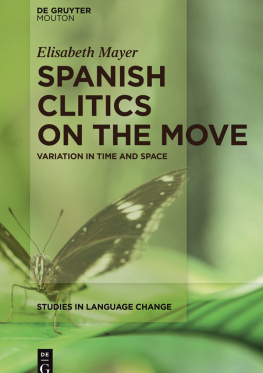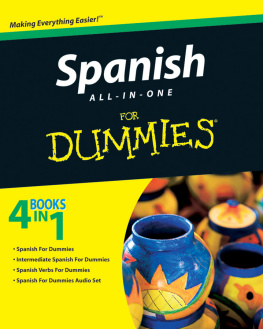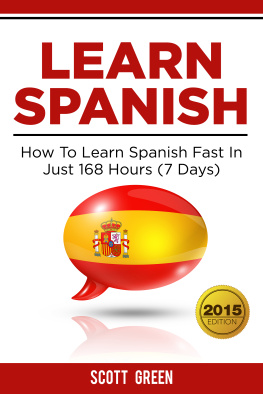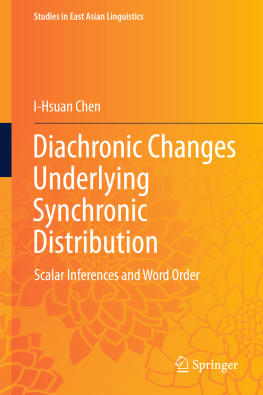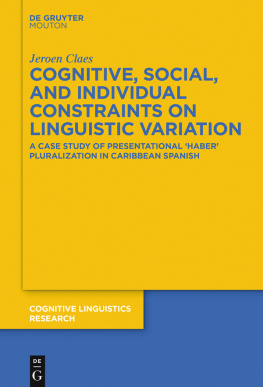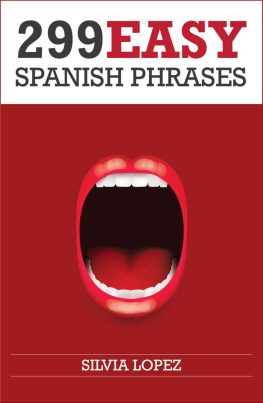Table of contents
Guide

Elisabeth Mayer
Spanish Clitics on the Move
Studies in Language Change
Edited by
Cynthia Allen
Harold Koch
Malcolm Ross
Volume 14

ISBN 978-1-61451-588-3
e-ISBN (PDF) 978-1-61451-421-3
e-ISBN (EPUB) 978-1-5015-0088-6
ISSN 2163-0992
Library of Congress Cataloging-in-Publication Data
A CIP catalog record for this book has been applied for at the Library of Congress.
Bibliographic information published by the Deutsche Nationalbibliothek
The Deutsche Nationalbibliothek lists this publication in the Deutsche Nationalbibliografie; detailed bibliographic data are available on the Internet at http://dnb.dnb.de.
2017 Walter de Gruyter Inc., Boston/Berlin
Cover image: iStockphoto/thinkstock
www.degruyter.com
Acknowledgments
This book has evolved from my doctoral thesis about the co-evolution of clitics and differential object marking in non-standardized monolingual and bilingual Peruvian Spanish varieties. Clitics are small words with many functions. They are notoriously difficult to define, complex and often highly confusing. All of these attributes make them an intriguing and fascinating topic, they are worthwhile to work on and never boring. While the core arguments have remained the same, the emphasis has shifted from a mainly synchronic account of the complex relationship clitics exhibit in clitic doubling, to a diachronically-based portrayal of a scalar clitic system, arising from dialect/language contact.
I want to express my gratitude to the editors of the Studies in Language Change series, Cynthia Allen, Harold Koch and Malcolm Ross for the opportunity to publish this book in their series, and for advice on the book proposal and continuing support. To Cynthia Allen I owe a great deal for critically reading the manuscript and providing constructive and invaluable advice on opening this book to a wider audience. I am indebted to Susan Ford for skilful editorial work on the monograph. I also thank the editors at De Gruyter Mouton, especially Lara Wysong and Wolfgang Konwitschny for their patience and excellent professional support.
I gratefully acknowledge financial support for collection of the corpus data for this project from the Australian National University in form of a Fieldwork Grant and a Vice-Chancellors Travel Grant.
I am deeply indebted to indigenous people, family and friends in Peru for generously sharing their languages, stories, time, and resources. I am also grateful to my colleagues at the PUCP in Lima for an intellectually stimulating and welcoming environment where the original concepts for this book evolved towards maturity. I am particularly thankful to Liliana Snchez and Jos Camacho for being a continuous source of learning, support and inspiration.
This monograph has greatly benefitted from feedback from colleagues at the Australian National University and valuable comments from colleagues at conferences and seminars. It owes a great deal to them, and most importantly to Avery Andrews for significantly shaping my linguistic thinking over the years.
And finally, my deepest personal gratitude goes to my linguistically diverse family around the world, particularly to Jorge a linguistically not so nave reader Johanna and Peter, Bernardo and Kaccey, for allowing me to sacrifice family time and for their unfailing and unflailing encouragement.
I dedicate this book to Manu and to our multilingual family.
List of tables
Abbreviations
| ACC | accusative case |
| AGR | agreeing feature |
| ANIM | animate |
| AUX | auxiliary |
| C | constraining |
| CL | clitic |
| CLD | clitic doubling |
| COM | comitative |
| COND | conditional |
| CONJ | conjunction |
| DAT | dative case |
| DEF | definite |
| DEM | demonstrative |
| DET | determiner |
| DIMIN | diminutive |
| DO | direct object |
| DOM | differential object marking |
| ETHDAT | ethical dative |
| F | feminine gender |
| FOC | focus |
| FUT | future tense |
| GEND | gender |
| GF | grammatical function |
| IMP | imperative |
| IMPERS | impersonal |
| IND | indicative |
| INDEF | indefinite |
| INF | infinitive |
| IO | indirect object |
| LA | Latin America |
| LS | Limeo Standard Spanish |
| M | masculine gender |
| N | neuter gender |
| NP | noun phrase |
| NUM | number |
| OBJ | object |
| OBJ | restricted object |
| OBL | oblique |
| OM | objective marker |
| P | preposition |
| PARTIC | participle |
| PAST | past tense |
| PERF | perfect aspect |
| PERS | person |
| PL | plural |
| PN | proper noun |
| POSS | possessive |
| PP | prepositional object |
| PRED | predicate feature/lexical form |
| PRO | pronoun |
| QUANT | quantifier |
| RECIPR | reciprocal |
| REFL | reflexive |
| REL | relative |
| RP | River Plate |
| S | sentence |
| SBJV | subjunctive |
| SG | singular |
| SPEC | specific |
| SUBJ | subject |
| TOP | topic |
| TOP2 | secondary topic |
| VP | verb phrase |
Chapter 1
Introduction
This book is about the genesis of a subset of feature-reduced clitics and their syntactic/pragmatic functions in Limeo Spanish contact varieties of Peruvian Spanish. These clitics, which arise as non-standardized variation embedded in a variety of contact and second language acquisition scenarios, exhibit different grammaticalization stages and extended grammatical functions. The book presents a theoretically oriented description linking the clitic variability and innovation found in these dialects to language change in progress. The argument is then extended to show that these innovations are not restricted geographically but can be found in contact situations across the Spanish-speaking world.
1.1Clitics and argument marking
Clitic pronouns are morphological markers at the interface of syntax and phonology, morphology, semantics and information structure (Belloro 2007; Ordez and Repetti 2006; Spencer and Lus 2012; Zwicky 1985). They are phonologically unstressed bound morphemes and as such dependent on a verbal host. Proclitics as in (1b), occur as single words immediately before the verb, enclitics attach verbfinally as suffixes in (1c). In their morphology, Spanish clitics express the features person, gender, number and case, and play an important role in argument marking (Harris, 1995). As anaphores, feature-agreeing clitics replace propositions or noun phrases as in the feminine clitic la in (1b) and (1c) referring to the noun phrase Mara in (1a).

